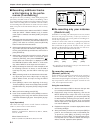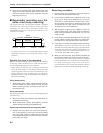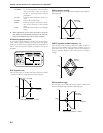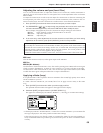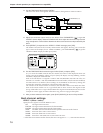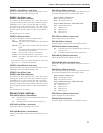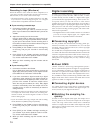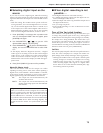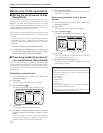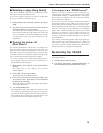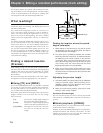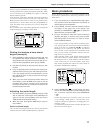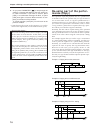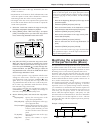
Recording to tape (Mixdown)
When the balance of the tracks has been completed, use
your stereo recorder (cassette tape recorder, DAT recorder,
MD recorder, etc.) to create a stereo master tape.
* The digital interface of the VS-880 comforms to S/P DIF.
If you wish to record the digital signal, use a digital
recorder that is compatible with these standards.
● If you are using a cassette tape
1. Connect the recorder to the VS-880.
Use an RCA phono type cable to connect the input
jacks of your recorder to the MASTER OUT jacks of the
VS-880.
2. Adjust the recording level of the recorder.
Use the master fader to adjust the output level of the
VS-880, setting it as high as possible without overload-
ing the input of the recorder. Set the recording level of
the recorder so that the level meters indicate as high as
possible without causing distortion.
3. Press [ZERO] on the VS-880 to return to the beginning
of the song, and put your recorder in record ready
mode.
4. Press [PLAY] on the VS-880, and begin recording on
your recorder. If you wish to produce a fade-in or fade-
out, use the master fader of the VS-880.
5. When you finish recording, stop the recorder and the
VS-880.
● If you are using a DAT
1. Connect the recorder to the VS-880.
Use an RCA phono type coaxial cable to connect the
digital input connector (coaxial) of your digital recorder
to the DIGITAL OUT connector of the VS-880.
2. If you have connected a digital recorder by a digital
connection, make settings on your digital recorder so
that it will record from its digital input. Also, set the sam-
ple rate of the recorder to match the sample rate at
which the song was recorded (44.1 kHz). Many digital
recorders automatically sense the sample rate of the
recording source, so that it is unnecessary to make this
setting manually.
* Some DAT recorders are not able to record a digital signal
at a sample rate of 44.1 kHz. In this case, use analog con-
nections instead, and set the digital recorder to record
from its analog input.
* If you do not know the songÕs sample rate and recording
mode, Hold down [SHIFT] and press [SONG].
3. Press [ZERO] on the VS-880 to return to the beginning
of the song, and put your recorder in record ready
mode.
4. Press [PLAY] on the VS-880, and begin recording on
your recorder. If you wish to produce a fade-in or fade-
out, use the master fader of the VS-880.
5. When you finish recording, stop the recorder and the
VS-880.
Digital recording
In order to record the output of a digital audio device such
as a CD player, DAT recorder, MD recorder, or DCC
recorder directly into the VS-880 as a digital audio signal,
you must make the appropriate settings. There are also sev-
eral points which you must be aware of. This section
explains the process from the preparations for recording a
digital audio signal to specifying the digital audio signal as
the input source. The rest of the recording procedure is the
same as when recording an analog signal, and will be omit-
ted from the explanation.
* The digital interface of the VS-880 conforms to S/P DIF. If
you wish to record a digital signal, use a digital audio
device that is compatible with these standards.
■ Concerning copyright
The law prohibits the unauthorized recording, public per-
formance, broadcast, sale, or distribution etc. of a work (CD
recording, video recording, broadcast, etc.) whose copyright
is owned by a third party.
The VS-880 does not implement SCMS. This design decision
was made with the intent that SCMS should not restrict the
creation of original compositions which do not violate copy-
right law. Roland will take no responsibility for any
infringement of copyright that you may commit in using
the VS-880.
■ About SCMS
ÒSCMSÓ stands for ÒSerial Copy Management System.Ó
This is a function that protects the rights of copyright hold-
ers by prohibiting recording via a digital connection for
more than two generations. When digital connections are
made between digital recorders that implement this func-
tion, SCMS data will be recorded along with the audio data.
Digital audio data which contains this SCMS data cannot
again be recorded via a digital connection.
■ Connecting digital devices
Use a RCA phono type coaxial cable to connect the DIGI-
TAL IN connector of the VS-880 to the digital output con-
nector (coaxial) of your digital audio device.
■ Matching the sampling fre-
quency
In order to record a digital audio signal, the sample rate of
the song must be set to match the sample rate of the input
source. The song created when a disk drive is initialized
will have a sample rate of 44.1 kHz. If the sample rate of the
input source is other than 44.1 kHz, create a new song with
that sample rate (p.62).
Chapter 3 Basic operation (as a replacement for a tape MTR)
72



